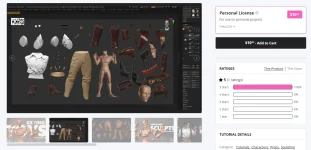
Complete Guide ZBrush Preparing Sculpts For 3d Printing Full Course
"Master the art of preparing digital sculpts for 3D printing! Learn essential techniques to optimize models for successful 3D prints with precision and efficiency."
Introduction to Preparing Sculpts for 3D Printing
3D printing has revolutionized the way digital artists and sculptors bring their creations to life. However, transitioning a sculpt from a digital medium to a physical model requires careful preparation. Properly optimized models ensure smooth prints, structural integrity, and reduced material costs.
✔ Why is Preparing Sculpts for 3D Printing Important?
Ensures the digital model is print-ready with correct geometry and dimensions.
Prevents issues like failed prints, weak supports, and excessive material usage.
Optimizes surface details for high-quality physical output.
✔ What You Will Learn?
Techniques to optimize and prepare digital sculpts for printing.
Importance of wall thickness, support structures, and file formats.
Common troubleshooting methods for successful 3D prints.
Essential software tools for slicing and exporting printable models.
Step-by-Step Breakdown of the 3D Print Preparation Process
✔ 1. Optimizing Digital Sculpts for Print Quality
Reducing high-poly counts without losing essential details.
Ensuring smooth surfaces for clean prints.
Balancing resolution with printer capabilities.
✔ 2. Setting Proper Wall Thickness & Structural Integrity
Avoiding overly thin or thick walls that impact print stability.
Reinforcing weak points to prevent breakage.
Adding internal support structures for complex models.
✔ 3. Hollowing and Drainage Techniques
Reducing material usage to lower printing costs.
Implementing drainage holes to remove excess resin or filament.
Avoiding internal pressure build-up that leads to print failures.
✔ 4. File Exporting & Format Compatibility
Understanding STL vs. OBJ file formats.
Adjusting slicing software settings for optimal print results.
Ensuring models are correctly scaled for real-world printing.
✔ 5. Troubleshooting Common 3D Printing Issues
Fixing layer gaps, poor adhesion, and print warping.
Addressing overhangs and support-related problems.
Refining print settings for improved accuracy.
Best Practices for Preparing Sculpts for 3D Printing
✔ Ensuring Clean Geometry
Eliminating non-manifold geometry and floating vertices.
Using boolean operations properly for watertight meshes.
Checking for intersecting meshes that can cause print failures.
✔ Balancing Detail & Efficiency
Keeping a reasonable polygon count without sacrificing details.
Using normal maps to enhance surface details without increasing geometry.
Testing low-resolution versions before committing to full prints.
✔ Selecting the Right 3D Printer & Materials
Understanding FDM vs. SLA printing technologies.
Choosing filament or resin based on project needs.
Calibrating printers for precise and reliable output.
Final Thoughts & Learning Resources
✔ Who Should Learn 3D Print Preparation?
Digital Sculptors looking to bring their creations into the real world.
Hobbyists & Makers interested in custom miniatures and collectibles.
Game Developers & Concept Artists prototyping 3D assets.
✔ Recommended Software for 3D Print Preparation
ZBrush / Blender (for sculpting and optimizing meshes)
Meshmixer (for hollowing and fixing print issues)
PreForm / Chitubox (for slicing resin-based prints)
Cura / PrusaSlicer (for FDM printing and supports)
Support the Creator: FlippedNormals 3D Printing Guide
Legal Disclaimer: CGPeers.in is an independent educational platform providing informational content shared by its global user community. We DO NOT host, store, promote, or distribute any copyrighted material, illegal downloads, or pirated content. Responsibility for all uploaded content lies solely with the individual user who submitted it.
By accessing this website, you agree that you are doing so at your own risk. CGPeers.in, its owners, administrators, hosting providers, and domain registrars assume no liability for any legal claims, damages, or actions arising from third-party user submissions or external links.
CGPeers.in operates under strict compliance with international copyright laws, including the Digital Millennium Copyright Act (DMCA). For any copyright concerns, please file an official complaint via our DMCA Policy. We respect original creators and encourage all users to support legal, official products and avoid unauthorized use of intellectual property. CGPeers.in is committed to compliance with Google AdSense policies by maintaining a high-quality, policy-friendly environment focused on education, creativity, and industry knowledge. For any legal inquiries or takedown requests, please contact us through the official communication channels available on our website. Support Creativity. Respect Copyright. Protect Innovation.
Last edited by a moderator:





 ❤
❤
